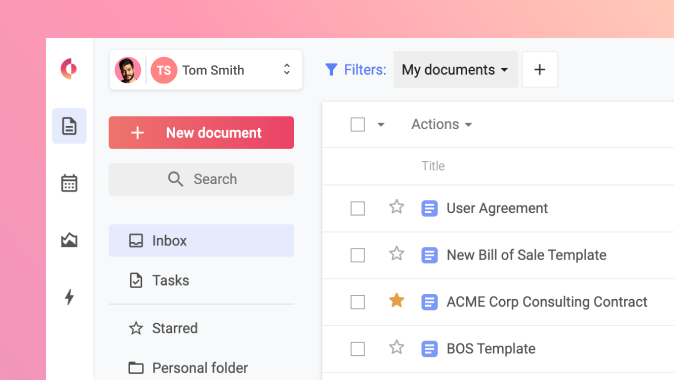Buying E-Signature Software? Consider the Real Cost
Would you build an addition to your house without having thought about a doorway to the rest of your home, or properly hooking up electrical connections? Of course you wouldn’t! But similarly, if you’re considering e-signature software, you’re not simplifying your work in the long run, you’re actually creating more roadblocks to both the contract process — and your digital workplace as a whole.
Instead of buying e-signature software, it is often a better idea to choose a contract management tool with an e-signature feature. Why is that? With a simple e-signature software approach, you may wind up with a fragmented digital space that fosters problems you’ve already encountered, or will soon.
These problems include everything from frustrating disorganization, lost contracts, security concerns, compliance issues, and even increased operational costs.
Here’s what may be at stake, and how integrating a contract management tool instead of e-signature software can simplify not only signatures but each leg of the contract management process.
Multiple Tools Equal Multiple Headaches
Whether your business is legal, procurement, healthcare, real estate, or construction, no matter your industry, if you need e-signature software it’s because you’re signing many agreements or contracts. In all of these sectors, your contracts need management throughout their whole lifecycle to ensure efficiency, good organization, and compliance.
If you’re buying a digital workplace tool like e-signature software, you should consider how the tool factors into your workplace overall in the following ways.
E-signature software should foster:
- Better communication
- Smoother collaboration
- Seamless file sharing
- Enhanced productivity
It should also be the best business application for your needs.
On the surface, e-signature tools solve some of these needs but leave holes in underlying equally important contract process needs, such as governance, security, and broader collaboration flexibility.
Does Your Business Experience These Process Problems from E-signature Software?
Still, many businesses continue to operate in a time warp. While that might be a fun sing-along to the Rocky Horror Picture Show, a piecemeal approach to contract management software is costing your business and employees both time and money.
Can you say yes to one or more of these statements?
- Signed documents are stored in various spaces, and sometimes there is more than one copy.
- Contract information is tracked on a spreadsheet that involves only one or two gatekeepers, and this provides no visibility for the rest of the team or organization.
- Only one or two people can track deadlines, and our organization must go through them for key data.
- Templates take a long time to create and are sometimes re-created.
- Negotiation involves a lot of email tracking, and tedious attention to the thread, and sometimes there are mistakes.
If you answered yes to one or more of these statements, your organization is effectively saying yes to daily frustration. So in reality, if you’re opting solely for e-signature software, you’re not solving these bottlenecks.
In many cases, businesses and people alike do what’s familiar, not what’s efficient, until it’s causing too many problems to continue.
Let’s walk through the process many businesses take when they purchase just an e-signature tool and the business problems that naturally come up. These problems highlight a need for better security and processes with end-to-end contract management software.
Where Do You Store Signed Contracts?
You’re thinking about e-signature software solutions, but what about contract storage considerations?
Many e-signature tools today offer overlapping features, from legal digital signatures to signature tracking. But where do you store the signed contracts? Like most companies, your business likely opts to store contracts on local or cloud-based electronic spaces. However, the process can shift with employee turnover, and it creates little to no visibility for other departments. It also makes it hard to track details in an agreement.
CLM Software Storage is Both Accessible and Secure
Fragmented tools and apps slow down an organization. A contract lifecycle management (CLM) tool that includes an e-signature feature enables your organization to obtain a legal digital signature and then to store it in a secure cloud-based space, as well as upload it to the spaces you normally use, like Google Drive, or Salesforce.
Unlike a simple electronic signature tool, when a detail changes in Concord’s CLM, that data automatically updates in key spaces you work with, like Salesforce. So you never have to worry about correct contract information and details. In addition, you have better visibility. Moreover, you can have confidence that you can find the right contract in the same place, every time.
When it comes to operational costs, if you buy e-signature software, you’re paying for one leg of the process. But with most CLMs, you pay a similar amount for the entire contract management process.
Here’s How Concord Makes it Easy for Legal to Automate Compliance
How Does Your Business Create Legal Templates?
Creating a contract, or crafting a legal template, is one of the first steps in the contract process. The truth is, most companies are out of step with this — and it’s why we reviewed the e-signature process, first, because it’s what you most likely did, too!
E-signature software, by and large, doesn’t come with templatized legal documents. But this is a critical need for your digital workplace process. E-signature software and an added template service aren’t integrated, nor do they create cost savings.
Create Pre-approved Templates in CLM Software
A CLM tool allows you to import any document and begin building templates with pre-approved legal clauses. You can upload as many documents as you want with no size limitations, and include data from Salesforce or Excel.
Automation in the digital space is key. Templatizing legal documents enables any industry, from procurement, to real estate, or construction, to have the right legal documents handy in one space.
Where and How Do You Negotiate Agreements?
By now you must be on to us. You see how backward these steps are in this post, but many times this is the reality of how businesses manage contracts and digital tool procurement.
When it comes to contract negotiation, most businesses negotiate in person, or by phone, and then by email.
The fact is, you’re negotiating sometimes thousands or millions of dollars worth of business — by email. But email security concerns and risks have risen in the last 5 years. CSO online shows that 94% of malware comes through email, and file-less attacks ballooned by 256% in the last half of 2019.
Negotiate and Redline Safely, Effectively, and Easily in CLM Software
A CLM allows you to redline and negotiate all in one secure space. You’ll never track a critical detail through email again. You can look up details, and have version control security.
Contract management software allows all parties visibility into the negotiation and redline process, meaning your sales teams and stakeholders will be able to navigate deals better.
In the short term, e-signature software is a stop-gap for getting agreements signed. But if you idle there long enough, eventually, you’ll sputter into process headaches. A CLM tool allows you to not only sign but create, track, and even make reports to manage your agreements more easily. Simplify your process. Make it easier, more effective, and more secure with end-to-end contract management.



